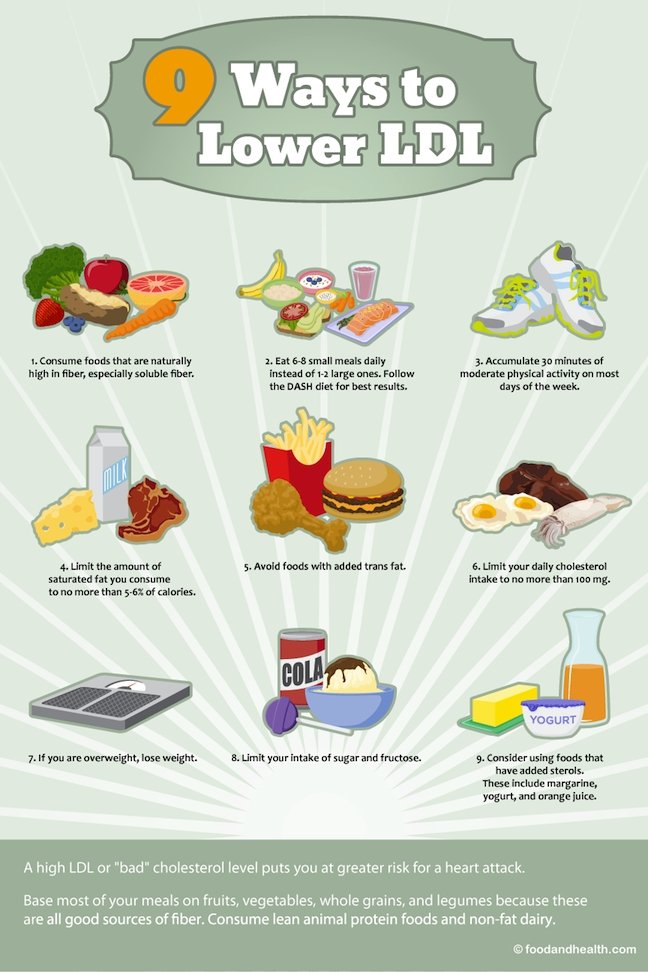Discover the hidden secrets to reducing LDL cholesterol levels without medication in this informative and eye-opening blog post.
Table of Contents
Introduction to Cholesterol
Cholesterol might sound like a big, scary word, but it’s actually something very important to understand, especially when it comes to taking care of our bodies. Let’s break it down a bit. Cholesterol is a waxy, fat-like substance that our bodies need to function properly. One type of cholesterol that we hear a lot about is LDL cholesterol.
LDL Cholesterol Basics
LDL stands for low-density lipoprotein, but you don’t have to remember that whole term. Just know that LDL cholesterol is often referred to as the “bad” cholesterol. Why is it called “bad”? Because having too much of it in our bodies can clog our arteries and make it harder for our blood to flow smoothly, which isn’t good for our health.
The Downside of High Cholesterol
When we have high levels of LDL cholesterol, it can increase our risk of heart disease and other heart-related problems. That’s why it’s important to keep an eye on how much LDL cholesterol we have in our bodies and take steps to keep it at a healthy level.
Eating Well for Your Heart
When it comes to taking care of your heart, what you eat plays a big role. Let’s dive into how food can affect your cholesterol levels and learn how to choose heart-healthy options.
Heart-Healthy Foods
There are certain foods that can help lower LDL cholesterol, which is the bad kind of cholesterol. Fruits, vegetables, whole grains, and nuts are great choices that can keep your heart happy and healthy. These foods are full of nutrients that help keep your cholesterol levels in check.
Foods to Avoid
On the flip side, there are foods high in bad fats that you should try to limit or avoid altogether. Things like fried foods, sugary snacks, and fatty cuts of meat can raise your LDL cholesterol levels and aren’t the best choices for your heart. Opt for healthier alternatives to keep your heart in tip-top shape.
The Power of Omega-3
Omega-3 is a special type of fat that is super helpful for our bodies. It’s like a superhero that fights against the bad cholesterol, LDL. When we have enough omega-3 in our diets, it can actually help lower our LDL cholesterol levels. Isn’t that cool?

Image courtesy of nutritioneducationstore.com · In stock via Google Images
Sources of Omega-3
Now, you might be wondering where we can find this awesome omega-3. Well, there are lots of yummy foods that are packed with it. Foods like fish, especially salmon and tuna, are excellent sources of omega-3. You can also get omega-3 from nuts, seeds, and even from some plant-based oils like flaxseed oil. If you’re not a big fan of fish, you can always ask your parents about taking omega-3 supplements to make sure you’re getting enough of this powerful nutrient.
Getting Physical to Lower Cholesterol
Exercise is not just fun, it’s also great for keeping your heart healthy and lowering your LDL cholesterol levels. When you move your body, you’re helping your heart pump blood better and keeping your cholesterol in check.
Fun Exercises for Kids
There are so many exciting ways to get active and lower your cholesterol at the same time. Here are some fun exercises you can try:
1. Jump rope – grab a jump rope and start skipping for a heart-pumping workout.
2. Dance party – turn up the music and dance around the house to get your heart rate up.
3. Bike ride – hit the trails or bike around the neighborhood for a great cardio workout.
4. Playground games – play tag, kickball, or hide and seek with your friends to stay active and healthy.
Remember, staying active and moving your body is a fantastic way to keep your heart strong and your cholesterol levels in check.
Understanding Fats
In order to maintain healthy cholesterol levels, it’s important to understand the role that fats play in our diet. There are different types of fats that can either raise or lower LDL cholesterol, the “bad” cholesterol that can increase your risk of heart disease.

Image courtesy of www.pinterest.com via Google Images
Good Fats vs. Bad Fats
Good fats, like unsaturated fats found in foods such as avocados, nuts, and olive oil, can help lower LDL cholesterol levels. These fats are heart-healthy and should be included in your diet in moderation.
On the other hand, bad fats, such as saturated fats found in red meat and full-fat dairy products, can raise LDL cholesterol levels and should be limited in your diet. Trans fats, often found in processed and fried foods, are also harmful to your heart health and should be avoided as much as possible.
By making smart choices about the fats you consume, you can help control your LDL cholesterol levels and keep your heart healthy. Remember, it’s all about balance and moderation when it comes to fats in your diet.
Reading Nutrition Labels
Understanding how to read nutrition labels on food packages can help you make healthier choices for your heart. By checking these labels, you can find important information about the ingredients in the food you eat, including cholesterol and fats.
| Method | Description |
|---|---|
| Eat a heart-healthy diet | Include more fruits, vegetables, whole grains, and lean proteins in your diet. Limit saturated fats and avoid trans fats. |
| Exercise regularly | Physical activity can help lower LDL cholesterol levels. Aim for at least 30 minutes of moderate exercise most days of the week. |
| Quit smoking | Smoking can raise LDL cholesterol levels and increase your risk of heart disease. Quitting can help lower cholesterol and improve overall health. |
| Lose weight | Being overweight or obese can contribute to high LDL cholesterol levels. Losing even a small amount of weight can help lower cholesterol. |
| Drink alcohol in moderation | Excessive alcohol consumption can raise LDL cholesterol. Limit alcohol intake to one drink per day for women and two drinks per day for men. |
Spotting Hidden Cholesterol
When you look at a nutrition label, pay attention to the section that lists the amount of cholesterol in the food. Cholesterol is a type of fat that can raise your LDL cholesterol levels if you consume too much of it. Foods high in cholesterol include egg yolks, organ meats, and full-fat dairy products. Limiting these foods can help keep your cholesterol in check.
Additionally, watch out for foods that contain trans fats, as they can also raise your LDL cholesterol. Trans fats are often found in processed snacks, baked goods, and fried foods. Opt for foods that are labeled “trans fat-free” or have a low amount of trans fats to protect your heart.
Remember, by reading nutrition labels and being aware of what you’re putting into your body, you can take small steps towards maintaining a healthy heart and lowering your LDL cholesterol naturally.
Portion Control and Cholesterol
When it comes to keeping your cholesterol levels in check, one important factor to consider is portion control. But what exactly does that mean?

Image courtesy of www.doctorkatehenry.com via Google Images
What Are Portions?
Portions refer to the amount of food you eat at one time. It’s essential to understand that eating too much of certain foods can lead to an increase in LDL cholesterol, which is not good for your health. By keeping your portions in check, you can better manage your cholesterol levels.
When estimating portions, it’s helpful to use visual cues. For example, a portion of meat should be about the size of a deck of cards, a serving of pasta should be around the size of a tennis ball, and a serving of nuts should fit in the palm of your hand. These visual comparisons can make it easier to control how much you eat.
Remember, it’s not just about what you eat, but also how much you eat. By paying attention to your portions, you can help maintain healthy cholesterol levels and overall well-being.
The Role of Fiber in Your Diet
When it comes to managing your cholesterol levels, one key player in your diet is fiber. Fiber is a type of nutrient found in plant-based foods that your body can’t digest. Instead of being broken down and absorbed, fiber moves through your digestive system, helping to keep you regular and promoting overall good health.
Fiber-Rich Foods for Kids
For kids looking to increase their fiber intake, there are plenty of delicious and healthy options available. Foods like fruits, vegetables, whole grains, nuts, seeds, and legumes are all excellent sources of fiber. Here are some kid-friendly choices to help you boost your fiber intake:
1. Apples: An apple a day not only keeps the doctor away but also provides a good amount of fiber. Don’t peel the skin off, as that’s where most of the fiber is!
2. Carrots: Crunchy and colorful, carrots are not only tasty but also packed with fiber that’s great for your digestive system.
3. Whole Grain Bread: Instead of white bread, opt for whole grain varieties like whole wheat or whole grain rye for a fiber boost.
4. Beans: Whether it’s chickpeas, black beans, or kidney beans, adding legumes to your meals is a fantastic way to increase your fiber intake.
5. Berries: Blueberries, strawberries, and raspberries are not only sweet and delicious but also loaded with fiber that your body will thank you for.
Remember, increasing your fiber intake should be done gradually to prevent any digestive discomfort. Make sure to drink plenty of water along with your fiber-rich foods to keep everything moving smoothly in your digestive system.
Creating a Cholesterol-Lowering Plan
In order to lower your LDL cholesterol levels naturally, it’s essential to have a plan in place that includes a healthy diet and regular exercise. Here’s a step-by-step guide to help you get started and stay on track:

Image courtesy of www.pinterest.ca via Google Images
Setting Small Goals
First and foremost, it’s important to set achievable goals for yourself. Instead of trying to make drastic changes all at once, start small. For example, you could aim to add one extra serving of fruits or vegetables to your meals each day. Setting small, manageable goals will make it easier for you to stay motivated and track your progress.
By taking simple actions like incorporating heart-healthy foods into your diet and engaging in fun physical activities, you can make a big impact on your LDL cholesterol levels over time. Remember, the key is consistency and patience!
Conclusion
In conclusion, taking care of your heart health by managing your LDL cholesterol levels is essential for your overall well-being. By incorporating a healthy diet rich in heart-healthy foods, such as fruits, vegetables, whole grains, and lean proteins, you can naturally lower your LDL cholesterol levels. Including omega-3 sources like fatty fish, flaxseeds, and walnuts in your diet can further support a healthy heart.
Regular exercise, such as playing sports, riding a bike, or dancing, can also help lower LDL cholesterol and keep your heart strong. Remember to stay active and limit sedentary activities like watching TV or playing video games for extended periods. By making simple lifestyle changes, like being mindful of portion sizes and reading nutrition labels, you can take control of your cholesterol levels and promote good heart health.
It’s crucial to understand the role of different fats in your diet and focus on consuming good fats like those found in avocados, nuts, and olive oil while avoiding trans fats often found in processed foods. Additionally, including fiber-rich foods like fruits, vegetables, and whole grains can help manage your cholesterol levels and keep your heart healthy.
By creating a cholesterol-lowering plan that includes setting achievable goals for yourself, you can start making positive changes that will benefit your health in the long run. Remember, it’s never too early to start taking care of your heart, and with dedication and consistency, you can succeed in naturally lowering your LDL cholesterol levels through a healthy lifestyle.
FAQs
Can kids have high cholesterol?
Yes, kids can have high LDL cholesterol, although it is relatively rare. LDL cholesterol is often influenced by genetics and lifestyle factors, so it’s essential to keep it in check even at a young age. Eating healthy foods, staying active, and avoiding foods high in bad fats can help maintain healthy cholesterol levels.
How quickly can lifestyle changes affect cholesterol levels?
Changes in diet and exercise can have a positive impact on cholesterol levels within a few weeks to a few months. By incorporating heart-healthy foods like fruits, vegetables, whole grains, and lean proteins into your meals, and engaging in regular physical activity, you may start to see improvements in your LDL cholesterol levels over time. It’s essential to be patient and consistent with these healthy habits to achieve long-lasting results.





